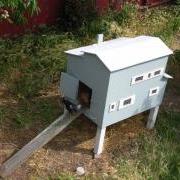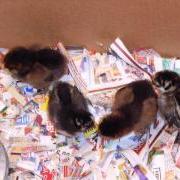In trying to create a more sustainable lifestyle, owning your own chickens is a very rewarding step.
 Our 4 chickens lay about 1 egg each per day. That means we get about 2 dozen eggs per week. We buy the most expensive organic chicken feed available at our local feed store for $25/bag. It works out to about $1-$2 per dozen eggs. Our chickens are free range in our yard and we have a great deal of control over what they eat and their happiness. NO scary factory farms! In addition to the organic chicken feed they consume some of our table scraps and eat the weeds out the garden. They love it when our son Byron doesn't finish his oatmeal and raisins in the morning (made with almond milk, not cows milk) . Nothing could be better to them. I have also included a recipe for scratch (a chicken's idea of cat nip) below.
Our 4 chickens lay about 1 egg each per day. That means we get about 2 dozen eggs per week. We buy the most expensive organic chicken feed available at our local feed store for $25/bag. It works out to about $1-$2 per dozen eggs. Our chickens are free range in our yard and we have a great deal of control over what they eat and their happiness. NO scary factory farms! In addition to the organic chicken feed they consume some of our table scraps and eat the weeds out the garden. They love it when our son Byron doesn't finish his oatmeal and raisins in the morning (made with almond milk, not cows milk) . Nothing could be better to them. I have also included a recipe for scratch (a chicken's idea of cat nip) below.
Having access to fresh eggs every morning has reduced the number of trip to the market for groceries and reduced the amount of meat we consume in general--not that we eat all that much to begin with. They eggs aren't trucked, there is no factory to power, no employees driving cars to work at the factory, and no additional refridgeration. I don't know how to quantify the impact that owning chickens has on our carbon footprint, but I feel that it has made a substantial reduction since food is generally the largest single contribution to an individual's footprint and animal products account for more than plant products.
Most municipalities have chicken ordinances. Our town allow 4 birds. San Francisco I believe allows 3.
In addition to providing us with eggs and the companionship of a pet, the chickens also control weeds and pests through non-toxic means (they eat them), and improve the soil by turning and fertilizing it. They love the tender spring weeds but are less thirlled with the tough summer weeds and thistles but they have completely erradicated the fox tails! When I was ready to plant my spring vegetables this year, I opened up the fencing around the bed and let them go to work. I pulled out the big weeds, but they took care of the rest. After a few days I was ready to plant and then I closed the fence back up so they wouldn't get my vegetables. We also collect up the beautiful feathers for art projects.
 Chickens are easy to care for. They are probably a little more work than a cat but less than a dog. They require fresh water each day and access to food. Chickens are self regulating so you dont have to worry about them over eating. They must be let out of their coop each morning and locked up every night. The coop is the single most important equipment involved in keeping chickens. You can buy ready-made coops online or on Craigslist. If you get a used coop, make sure to get advice on how to sterilize it. You can also build your own. A coop can be made from anything from an old dog house to a wine barrel. It must be easy to clean, ventilated to prevent the build up of ammonia, and able to resist a raccoon attack. Raccoons will rip a chicken to pieces in its sleep and this is why the chickens must be kept in a coop at night and locked up. Never underestimate raccoons. Its important to know that chicken wire is for keeping chickens out of your veggies not for protecting them. Chicken wire will not stop a raccoon.
Chickens are easy to care for. They are probably a little more work than a cat but less than a dog. They require fresh water each day and access to food. Chickens are self regulating so you dont have to worry about them over eating. They must be let out of their coop each morning and locked up every night. The coop is the single most important equipment involved in keeping chickens. You can buy ready-made coops online or on Craigslist. If you get a used coop, make sure to get advice on how to sterilize it. You can also build your own. A coop can be made from anything from an old dog house to a wine barrel. It must be easy to clean, ventilated to prevent the build up of ammonia, and able to resist a raccoon attack. Raccoons will rip a chicken to pieces in its sleep and this is why the chickens must be kept in a coop at night and locked up. Never underestimate raccoons. Its important to know that chicken wire is for keeping chickens out of your veggies not for protecting them. Chicken wire will not stop a raccoon.
 Chicks can be purchases for about $2.50 each from your local feed store. Make sure they have their vaccines. You will also need something to brood them in, a heat lamp and starter feed. We started our chicks in a large cardboard box next to the stove. Our box was about 2.5' x 2.5' x 3' tall. Chicks are much lighter than full grown chickens and are actually better jumpers than the adults. We hung the heat lamp over the box and lined the bottom with litter that had to be changed many times a day. We also changed it once in the middle of the night. Chicks are like any other babies, they poop a lot and are very noisy! Once our chicks started to fledge they got very very dusty so we moved them out of the house. We kept the coop in the basement to protect them from the low night time temperatures and continued to use the heat lamp. We moved them and the coop outside once they were almost fully grown. If you dont want to deal with brooding noisy, poopie chicks you can buy full grown hens and just go.
Chicks can be purchases for about $2.50 each from your local feed store. Make sure they have their vaccines. You will also need something to brood them in, a heat lamp and starter feed. We started our chicks in a large cardboard box next to the stove. Our box was about 2.5' x 2.5' x 3' tall. Chicks are much lighter than full grown chickens and are actually better jumpers than the adults. We hung the heat lamp over the box and lined the bottom with litter that had to be changed many times a day. We also changed it once in the middle of the night. Chicks are like any other babies, they poop a lot and are very noisy! Once our chicks started to fledge they got very very dusty so we moved them out of the house. We kept the coop in the basement to protect them from the low night time temperatures and continued to use the heat lamp. We moved them and the coop outside once they were almost fully grown. If you dont want to deal with brooding noisy, poopie chicks you can buy full grown hens and just go.
 We have 2 Ameraucana and 2 Wyandottes. The Ameraucana lay colored eggs. Ours both lay green eggs. One lays a sage green, the other a moss green. Our Ameraucana stop laying in the winter but lay huge eggs spring, summer and fall. The Wyandottes lay small brown eggs and lay right though the winter. Our Ameraucana are more skittish but dont mind being picked up, carried around and generally loved like a floppy cat. The Wyandottes both hate being picked up and rule the yard even though they are smaller than the Ameraucana. It turned out to be a really great mix of birds for us.
We have 2 Ameraucana and 2 Wyandottes. The Ameraucana lay colored eggs. Ours both lay green eggs. One lays a sage green, the other a moss green. Our Ameraucana stop laying in the winter but lay huge eggs spring, summer and fall. The Wyandottes lay small brown eggs and lay right though the winter. Our Ameraucana are more skittish but dont mind being picked up, carried around and generally loved like a floppy cat. The Wyandottes both hate being picked up and rule the yard even though they are smaller than the Ameraucana. It turned out to be a really great mix of birds for us.
A real great website for more information including supplies, how tos and deciding what breeds are right for you is:
http://www.backyardchickens.com/
The one bit of advice I would like to add it if you live in an area with hawks, but sure to get large standard breeds and not bantams.
Scratch is made from whole seed and is just thrown out to the chickens. They get really excited and love to go mad scratching in the dirt to find all the seeds. Our chickens will even eat it out of our hands. Here is a formula I down loaded from the internet and use as the basis for what I give our chickens a few times a week.
Ronda's Whole Grain Chicken Feed
- 2 parts whole corn
- 3 part soft winter wheat
- 3 part hard red wheat
- 1 part hulled barley
- 1 part oat groats
- 1 part shelled sunflower seeds
- 1 part millet
- 1 part kamut
- 1 part amaranth (I use buckwheat instead)
- 1 part split peas
- 1 part lentils
- 1 part quinoa
- 1 part sesame seeds
- 1/2 part flax
- 1/2 part kelp granuals (I leave this out because its expensive and they tend to leave it behind. Im confidant they are getting balanced nutrition from the pellet feed even without it.)
- free choice of granite grit (I also leave this out because our chickens free range over a large area and are able to pick up their own grit)
- free choice of oyster shells (I put in about 2 parts)
- Log in to post comments